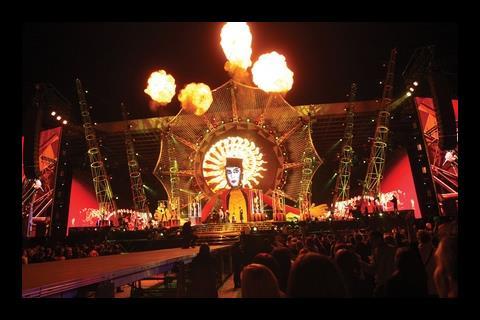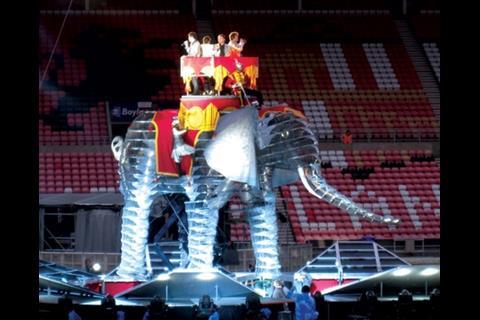Well, with its giant mechanical elephant, big top and 10m-high puppet ringmaster, Take ThatŌĆÖs new show is certainly surreal. But who designs and builds this sort of stuff? Thomas Lane went behind the scenes at the fastest-selling show in UK pop history
A stage opens up like the petals of a flower and four figures slowly rise up on a platform ŌĆō a platform that gradually reveals itself to be balanced on top of a giant, 7.6m-tall mechanical elephant. Then a section of the circular stage swings away and the elephant performs a full turn, blows some water from its trunk and begins to move towards a main stage 50m away ŌĆ”
Welcome to the opening of the fastest-selling show in UK pop music history. The four figures standing on the elephantŌĆÖs back are better known as Take That and this is their Circus Live tour, which kicked off last Friday at the Stadium of Light in Sunderland, before taking in a further seven stadiums across the country.
The show continues in the same vein as its bizarre opening ŌĆō as the band steps onto the main stage, a big top rises and in front of it an enormous top hat begins to emerge, eventually revealing the whole 10.4m body of a puppet ringmaster. As the band sings on, perched on a small platform in front of the ringmasterŌĆÖs head, its 11m-long arms move round and embrace them protectively.
You may not be a huge fan of the group, but there is no denying that its stage set is pretty groovy. And although the end product is rather different to most construction projects, there are some definite similarities between the two worlds: many of the people working in this business have backgrounds in construction; the hours are punishing; the financial risk is huge;and the client can change its mind at the drop of a hat. But in the world of stage design you also have the added fun of designing and building elements that have never been tried before and, of course, dismantling the whole thing night after night and rebuilding it a few hours later in another city.
So what sort of world is it behind the scenes? For a start, there isnŌĆÖt much of a design brief. This particular show was conceived by stage designer Es Devlin, but itŌĆÖs down to Clay Brock to make it happen. He is the project manager for Brilliant Stages, the company that has delivered this project. Brock started off as a project manager in construction, but moved into the events world because he found buildings too boring. ŌĆ£The set designer dreams up these crazy ideas and has no idea how theyŌĆÖre going to work,ŌĆØ he says, quoting the ringmaster puppet as an example of what he has to work with. ŌĆ£They wanted a puppet that leans forwards, holds out its hands and goes ŌĆśbooŌĆÖ. That was our creative direction.ŌĆØ
ItŌĆÖs down to Brilliant Stages to take this minimal brief and make it work. In the same way that the construction industry gets in a team of consultants to design a project, Brock assembles a team of specialists. These include engineers who handle the mechanisms and people like structural engineer Malcolm Richards, who is a director at Capita Symonds (see box). They take the idea and work out what it might look like. They also have to consider how itŌĆÖs going to work, what effect the wind will have on it, whether it will be safe and reliable, how itŌĆÖs going to be erected, dismantled and packed into a container and, crucially, how quickly it can be put together for a sensible amount of money. ŌĆ£My job is to make sure we get it done on time and on budget with design intent,ŌĆØ says Brock.
The set designer dreams up these crazy ideas ŌĆ” They wanted a puppet that leans forwards, holds out its hands and goes ŌĆśbooŌĆÖ. That was our creative direction
Clay Brock, Brilliant Stages
Brilliant Stages works out how each ŌĆ£gagŌĆØ ŌĆō or element of the show ŌĆō is going to work, costs it, then sees if the designer wants to go ahead with it. ItŌĆÖs a risky business because 25% of the time the client says no and Brilliant Stages (or the equivalent company) has to swallow the cost of developing the idea. If the client does go ahead, itŌĆÖs still risky, because each gag is a prototype.
ŌĆ£We had to do this earthquake scene for Metallica, where two pylons had to crash to the ground in two seconds,ŌĆØ says engineer Andy Edwards of 3D Design, one of the specialists on the project. ŌĆ£Nobody else would touch it except us. It was a frightening gag and a nightmare to do but we made it work. You do it on the basis of a gut feeling ŌĆō you can do all the calculations, but you donŌĆÖt know if it will work until you try it.ŌĆØ
Getting the price right for this sort of thing is a little more than a gamble. ŌĆ£I call pricing ŌĆśswaggingŌĆÖ, which means a sophisticated wild-ass guess,ŌĆØ laughs Brock. He says there are eight gags on the Take That set and two of them wonŌĆÖt make any money for Brilliant Stages. ŌĆ£You have to price things, but you arenŌĆÖt always sure how it will work, so sometimes you get it wrong,ŌĆØ sighs Brock. ŌĆ£You get a feel for the show and what the market will bear and you do the best you can.ŌĆØ
If that wasnŌĆÖt risky enough, thereŌĆÖs also the problem of the client changing its mind ŌĆō and this happens all the time. ŌĆ£Anybody who is any good will change it ŌĆō you know that and price accordingly,ŌĆØ says Brock. But Brilliant Stages doesnŌĆÖt expect to make any money when this happens. ŌĆ£In construction, if they want something changed they will expect to pay for it,ŌĆØ he says. ŌĆ£In the entertainment world, if you try and get all your money back you will never get another job.ŌĆØ
But surely the margins make up for this? Not according to Brock; he says margins are typically 5% because the market is so competitive. He is coy about the budget for the Take That show, but admits itŌĆÖs at least ┬Ż1.6m, 40% of which is additional to the original scope of the work, or ŌĆ£scope creepŌĆØ, as Brock calls it.
A further challenge is that the job has to be delivered in a compressed timescale. Edwards says he started on the initial design last November, although Brilliant Stages did not get the green light until 12 February. People worked six days a week, typically starting at 6am and working through to 8.30 or 9.00pm. The constant changes of direction piled on the pressure, as the team would have to redesign elements in a short time, then build them.
We had to do this earthquake scene for Metallica where two pylons had to crash to the ground in two seconds
Andy Edwards, 3D Design
The set was finished on 1 May, then had to go through technical testing before being shipped up to the first venue, where there have been three days of full dress rehearsals.
Some elements, such as the stage, which is 2m above the ground to allow people to work beneath it, are standard, as are some of the mechanical elements. Small scissor lifts, for example, are useful for lifting up elements.
But even these standard elements are sometimes used in a novel way. The ringmaster puppet is constructed from five scissor lifts stacked one above the other. The one below the head has a cantilevered platform for the band to stand on. The scissor lifts are clothed with a body made from aluminium hoops joined with fabric ŌĆō these unfold as the puppet extends, like a jack-in-the-box. As with many mechanical elements, the puppet is controlled manually, by eight people, as there wasnŌĆÖt time to come up with computer control programmes; this makes it easier, cheaper and more readily understandable.
For obvious reasons, most of the structural elements are made from lightweight aluminium. Where possible elements are moved hydraulically, as this is more reliable than electric motors. Everything is designed to pack together as closely as possible to minimise the numbers of lorries needed to transport the show. As it is, 36 articulated lorries are the minimum needed to shift the set around. Once the show is finished, there are just 37 hours to get the set down, transport it to the next venue and erect it again, ready for the next performance.
So what sort of people work in this business? Brock describes them as people who are happy working outside their comfort zone and are good at making decisions, then working hands on to turn the decisions into reality. People have to be happy working long hours too. Maybe the construction industry isnŌĆÖt that bad after all.






























No comments yet